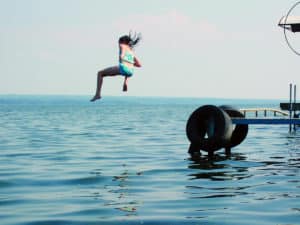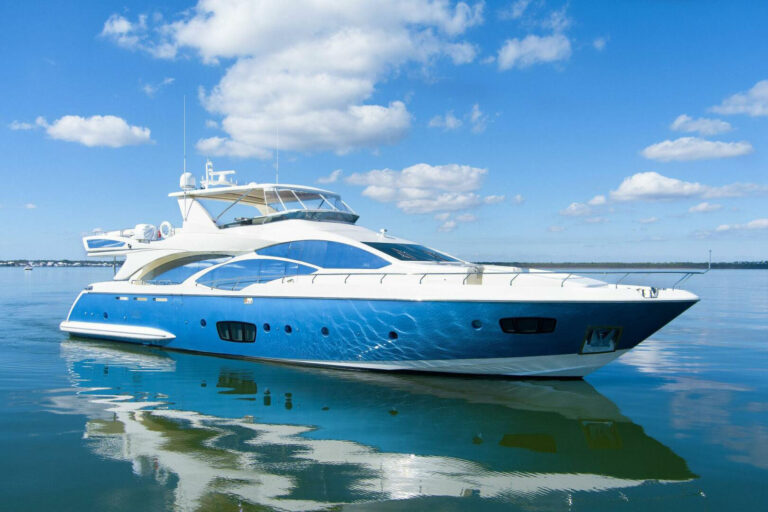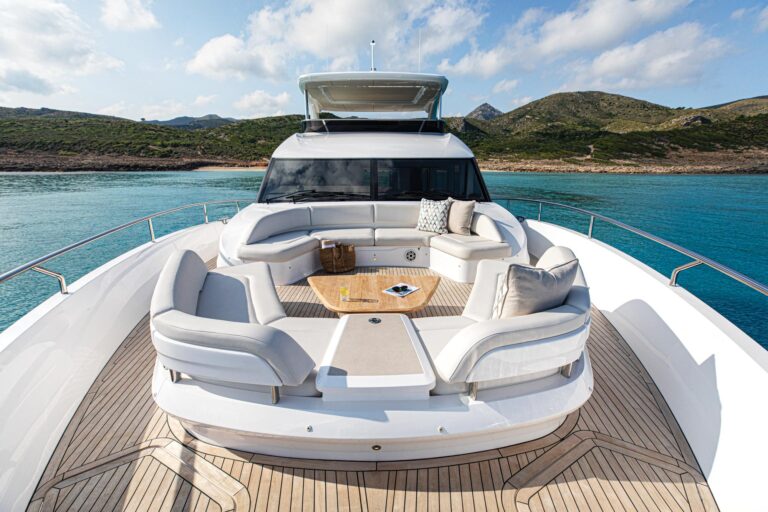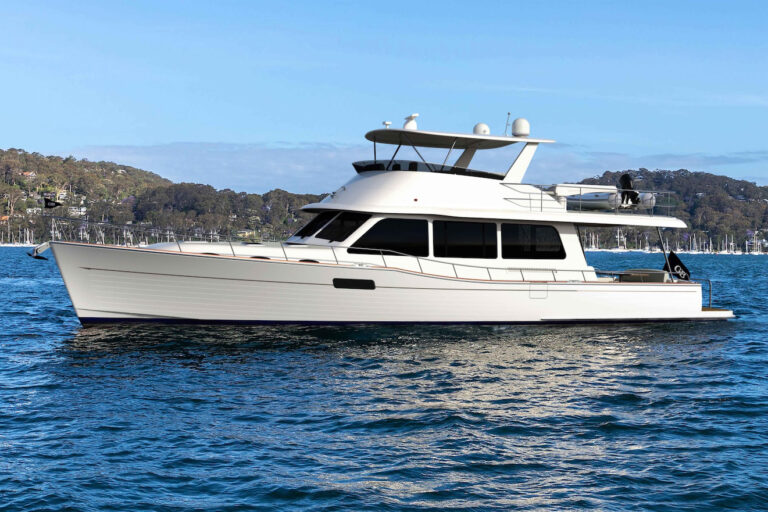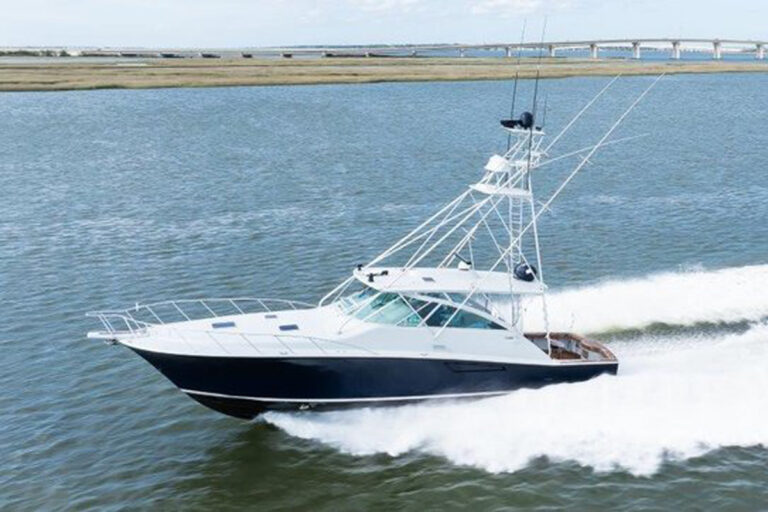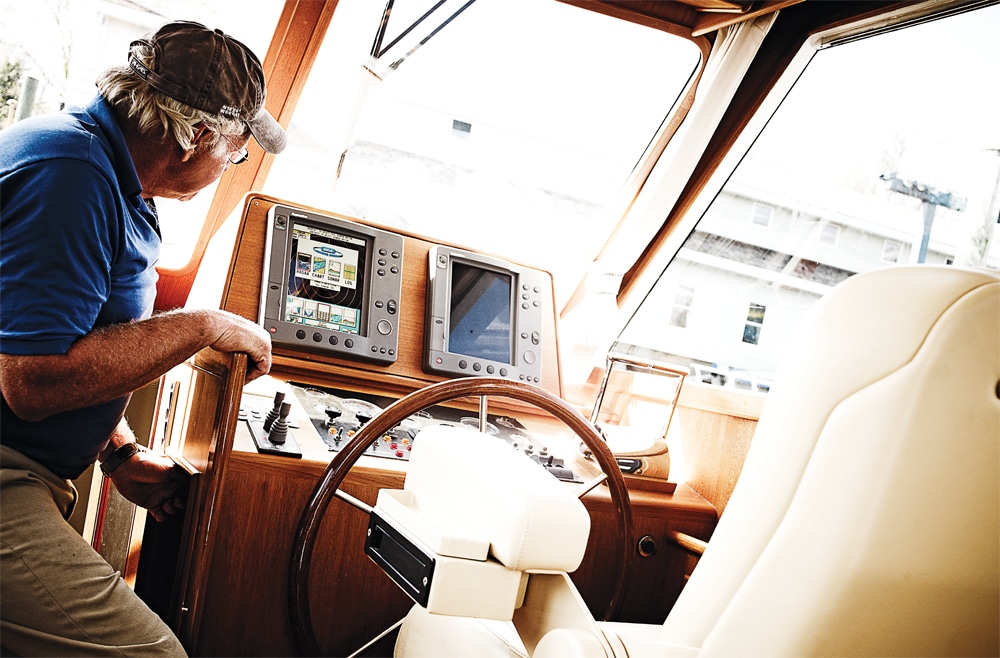
Become A Better Yachtsman
Living and working professionally aboard yachts over many years, one develops a seaman’s eye. Here, professional yacht captain Michael Howorth proves that the truly professional mariner is likely to have acquired a good dose of salty know-how to go with the brine in his blood.
It was Jimmy Buffett who sang of the son of a son of a sailor, and when he did so he could have been singing about me. When I was 13, my father, a salty old seafarer himself, packed me off to a school that taught the trade to budding merchant marine officers. I went to sea in the ’60s. Although this was well after the days of rounding the Horn under sail, I nevertheless learned my trade the hard way — at the hands of mariners through whose veins ran pure blue ocean brine. They taught me a great deal about maritime folklore and about the sea, that frequently cruel mistress we seafarers serve every time we leave the dock.
That is not to say I dismiss modern technology and would rather dump my GPS in exchange for my trusty sextant. Far from it. I fully embrace every conceivable device that makes sure yachting is as much fun now as it ever was. I have, however, in the many years I have served my mistress, learned she can have a twisted sense of humor, and my GPS can fail at precisely the same moment that someone opens the wheelhouse door and a big green one ships in and floods my chart table, rendering my paper chart unreadable pulp.
In short, I have learned to expect the unexpected and be prepared for the worst. I experienced the horror of all horrors when my yacht caught fire miles offshore, and I have lived to tell the tale. Being prepared does not have to be a pain in youknow- where. It’s all a matter of good common sense or — as we call it in yachting — seamanship. Here I have listed a few tips I’ve collected over the years.
Pre-Sea Check — Doors to check manually and cross-check
If you have ever flown in an airplane or piloted your own, you know that before you leave the ground there are mandatory checks to be carried out. While pilots never jump into a plane and just take off, there is a tendency for boaters to assume all is well and nothing has happened since they last used their yacht. Yet seacocks can weep, filling bilges; battery terminals corrode; and propane from the galley stove can fill a void. Left unchecked, these faults can prove fatal or, at best, uncomfortable. Having a printed form in hand may seem excessive, but if that’s what it takes to make sure you inspect the essential equipment prior to departure, including engine oil, fuel, fresh water, cooling water, bilges, radar, GPS and other navigational equipment, then make yourself one. Remember checklists for a long passage will be different from those for short trips. One last thing: Make sure you include a note to check that all hatches and other openings are closed before leaving port: one rogue wave + wet bed = a miserable night of recriminations. Trust me, I know!

Paper Chart Backup — When it hits the fan
All the fancy electronic chart plotters in the world have the same single basic flaw: They have an annoying habit of breaking down just when you need them most. It is never wise to rely solely on anything electronic, and the prudent mariner always has a plan B. Make sure you have at least a large-scale, up-to-date chart of the area you are cruising in and have it out where you can see it. Twenty years or so ago we fitted a chart plotter on our yacht for the first time and have never been to sea since without one. But we have never left the paper charts behind either and still make a point of noting the intended course in pencil before each leg of a voyage. Online almanacs and tide tables are as alluring as chart plotters, not least because they always contain up-to-date information, but computers, and indeed satellite broadband, are also likely to fail when you need them most. There really is no substitute for paper, unless of course you have two of everything, independently wired and independently supplied with information from alternative sources. Do not neglect your paper backup charts or forget to update them regularly; your life may depend upon it.
Knives — Let’s cut to the point
Every seaman should carry a clasp knife. Blunt blades are almost as useless as no knife at all; in fact, they are more dangerous than no knife, because in an emergency when you need it most, it won’t cut the mustard, or the line. Remember also that blunt blades cause more accidents that end up in the emergency room than do the sharpest of knives. When choosing a knife, those fitted with marlinespikes are most useful. Stainless steel looks good and rusts less, but seldom holds its edge as well as tempered steel. Clasp knives must be fitted with a safety locking feature to ensure the blade does not close when in use. Sheath knives are very useful attached at various points on the yacht, rather than on your person. I always attach one close by the deck-stored life raft, to cut it free in an emergency. Add the task of sharpening all knives to your regular maintenance list.
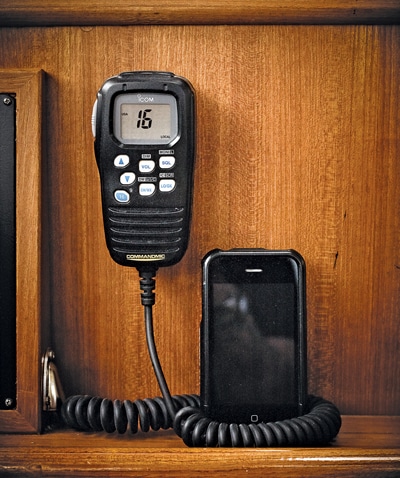
Safety Briefing — And notify those ashore before you go
When was the last time you gave a safety briefing to your own crew? Do they know where the life jackets are? Can they don one quickly in an emergency? Can they make a Mayday call on the VHF? Have they been shown where all the fire extinguishers are situated? Do they all know how to inflate the life raft? Do they know not to get into it until you, the captain, tell them to do so? These are all vital parts of your pre-departure captain’s briefing, which should be given no matter how many times the same crew have sailed with you. They may laugh at you for being a professional fusspot, but they will thank you in an emergency when they all know what to do. Before you leave the dock, make sure that at least one person staying ashore knows your plans, including your ETA at the destination and what to do if you fail to make contact on arrival.
Williamson Turn — The U-turn perfected
Nothing is more chilling than hearing the scream “man overboard.” So it really pays to know what to do. The Williamson Turn is the best way to get a boat back on a reciprocal course and take it back along its own wake. This is how you do it: Note the course you are currently steering. Turn off the autopilot if in use. Put the helm hard over to starboard and add about 60 degrees to the course. When the compass is on the new heading, put the helm hard over to port. When the yacht has turned through approximately 240 degrees and the compass reads the reciprocal course (i.e. course plus 180 degrees), center the wheel. The yacht will now be motoring back down the original track even if the weather makes it impossible to see the old wake. Reduce speed; the casualty should be somewhere straight ahead. The actual amount of turn on each heading varies from boat to boat and can be ascertained only by practicing beforehand. Practice makes perfect, so practice with a fender to become perfect.
Electrics Fail — Carry backups and spare batteries
Portable VHFs, handheld GPS and even the cell phone in your pocket rely on battery power. Of course, you charged everything before you left the harbor, didn’t you? The problem is, none of us is perfect and sometimes we do forget to plug things in or leave them on when they should be switched off. Flat batteries are annoying ashore but potentially dangerous at sea. Even the humblest flashlight is as useless as a chocolate sun hat if its batteries have no charge. A box containing spare batteries of the most common sizes is an essential item in your spares locker. Make sure younger members of the crew eager to power handheld electronic games have not looted it. Specialized spare batteries should be carried where possible for all electronic equipment. Keep spare chargers aboard for regularly used personal items, such as mobile phones and other handheld devices. Boats without generators should be fitted with low-voltage inverters to trickle-charge these devices when they need it. Do not forget to pack and regularly change out spare batteries in your grab bag.
Fire — Prepare for the worst
I think my worst moment at sea came just a few years ago when I was test-driving a new boat and the fire alarms went off. My first thought was that it must be a false alarm, but this was quickly dispelled by my chief engineer calmly saying, “Engine room temperatures are rising rapidly, Captain.” My own temperature immediately sank to icy cold. I was lucky: I had professional crew on board, we had practiced fire drills regularly, and the fire extinguishing system in the engine room worked perfectly. We got the fire out, and although it reignited once, no one was hurt and we got the yacht safely back to port with the help of a tugboat. Though the damage in the engine room was significant, it could have been far, far worse. I learned the true value of training, great crew and good equipment from that incident. Oh, in case you are wondering, yes, I did have the life rafts ready to go in case it all went pear-shape and we had to abandon ship. All the money in the world is not worth the life or health of one person.
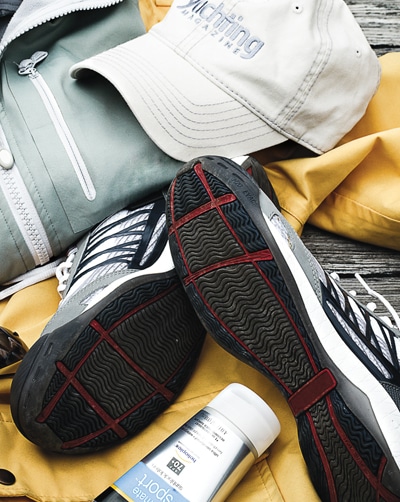
Clothing — Wear the appropriate kit
The clothing that crew wear on a sailboat enables them to go on deck and change sails in stormy weather. They are not the same as those required by the skipper and his friends on a nice enclosed motorboat. But there are still times you will be outside on deck in adverse conditions when under way, and even in the tropics it can be cool at night on passage. You will probably, at least occasionally, be at anchor and need to get ashore in an open tender — not much fun without proper gear when it rains. Shoes that grip wet or dry decks and that are non-marking should be worn to protect feet from injury. Sailing in the tropics is about protection from the sun because the cool feel of the air as the yacht motors can mask the strength of that fiery globe. Skin cancer is no joke, and even high-blockage sunscreen is seldom enough at midday on deck. Special clothes are not a fashion statement but a necessity.
Training — Update your own skills
There is an old ditty by Laurence J. Peter: When in doubt or danger, run in circles, scream and shout. When disaster strikes, most people will be stunned and bewildered. Untrained people often exhibit inappropriate patterns of behavior. In general, we all respond by falling back on well-learned patterns, and this is why the navies of the world practice again and again for emergencies of all kinds. Moreover, those who are trained to expect and to cope with disaster show infinitely greater survival rates over those who are not. Training is not exclusively about surviving worst-case scenarios, but being prepared means taking and retaking firefighting and first aid courses. It never hurts to reread the Rules of the Road occasionally, practice boat handling and keep up to date with the latest equipment. Train your crew; share your skills. Shoreside courses advance your knowledge, and there are plenty of practical courses too. Mostly they are fun, educational and a great way to make new friends with the same interests.

Knots — Know your knots; don’t get tied up
A sailor depends upon the ability to tie a bowline in the dark. It was the first knot I taught our children, and I insist that every crew member demonstrate he can tie this knot. It is not difficult to learn at any age, especially when the lesson is accompanied by the pneumonic “rabbit round the tree and down the hole.” The bowline is the ultimate lifesaving knot and, when tied correctly, can always be undone, yet it never slips. Other essential knots include: the square, or reef, knot to connect two ropes of the same diameter; the figure-eight knot as a stopper to prevent a line from running through a block; and last but not least, the clove hitch for attaching a rope on a fender to a yacht’s handrail. Once you have mastered these essential four, there are just a few others that are useful, such as a round turn and two half hitches and the sheet bend, a useful and better alternative to the reef knot when two ropes are of unequal size or wet.
Mooring Lines — Don’t leave synthetics in the sun
Modern lines stretch more, chafe less and last longer than their antecedents — that is, if you look after them properly. What manufacturers seldom say, except in small print, is that manmade fibers and bright sunlight do not mix. Even in temperate climes this remains a problem, because most of us prefer to go boating in sunny weather. Lack of under-deck storage is often stated as the main reason lines are left on deck. A seamanlike alternative is to cover them with a custom canvas. It keeps them out of the light and can look good too. Don’t forget to wash these lines when hosing down the deck with fresh water. This will extend their lives. Visually check lines carefully for sun damage, wear and chafe. I remember only too well one occasion when a badly maintained rope snapped, severely injuring the legs of the crewman on the foredeck.
Be Innovative — When it goes wrong, use your loaf
One of the greatest skills a seaman can develop is the intuitive use of innovative ideas. No matter how careful you are, things can go wrong at sea. Mostly these are minor irritants, but occasionally it is worse, not life-threatening but certainly annoying. Ashore you can drive down to the store, phone a friend or use Google to solve a problem. At sea, sometimes you have to make do and mend. I refueled one time down-island and set off for Bermuda, only to find the dock had also served me up a healthy dose of dirt from the bottom of its tank. Mr. Diesel did not like that. Too far from shore for help, we had to strain the fuel, gallon by gallon, through the only suitable device we had on board — coffee-filter papers. It worked perfectly, albeit very slowly, and we arrived safely. On another occasion a sailing friend of mine hacked the top and bottom off an empty fire extinguisher. He used his creation to join the two broken parts of his mainsail boom.
Oil and Water Do Not Mix — And if they do, here’s what you do
I am not sure I should really be telling this tale, since it is truly embarrassing to admit my error. Let me first say there were mitigating circumstances: It had been a long passage from Venezuela to Antigua, we were very short-handed, and I was very tired when we arrived in English Harbour. Low on fuel, we went straight alongside the fuel berth and began to fill the tanks belowdecks. The first tank filled surprisingly quickly, and it was only as I took the hose out that it dawned on me why. I had filled one of my half-empty freshwater tanks. It took 24 hours and one tanker to empty the contaminated liquid and a rather battered credit card before we slunk off the dock. The moral: Never ever try to do anything when you are too tired to think straight. Oh, and always mark the water tanks “Fresh Water” in extremely large letters right by the filler hole.
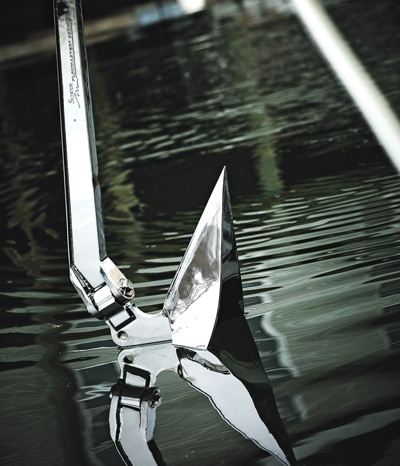
Where to Park — The art of dropping the anchor right the first time
I have watched, and have to admit taken part in, a few arguments over where to anchor. It seems a common occurrence between partners aboard a yacht. Which side of the bay is best?, where is it easiest to get ashore?, and who is nearby? are but a few questions that cause strife. Safety must always be the first priority when choosing your spot. It is never fun to re-anchor in the middle of the night because the wind has picked up and the boat is starting to drag anchor. Anyone who has been sailing a few years has experienced this at least once. To ensure re-anchoring is kept to a minimum, know the anchor and the seabed beneath your boat; take into consideration the rode of other yachts anchored close by, remembering that sailboats swing differently from motoryachts; and always use a snubber for quiet and peace of mind.
Corrosion — The marine equivalent of foot-and-mouth disease
Yes, it is called stainless steel, but remember this is stain-less, not rust-free as many people think and wish. Rust and corrosion are the yacht owner’s worst enemies, and they seem to creep up and spread like cancer. While rust on deck fittings is just unsightly, at least in the early stages, other corrosion can be deadly. Seacocks and through-hull fittings are often overlooked during maintenance, lying as they do hidden in the bilges. At the start and end of every season, the good seaman checks his seacocks to make sure they are working correctly and moving freely. If you have not hauled your boat recently, consider diving under her (or hiring a diver) to visually check the through-hulls for the early signs of corrosion. Caught in time, corrosion can be halted. Visually, many items, such as hose clamps in the engine room, bilges and heads, can look perfect, so touch and rattle gently to see that they are sound. On critical items, such as cooling-water hoses, I like to use not one, but two, stainless-steel clamps.
Salvage — Carry the correct forms and understand the basics
Should the worst happen and your motoryacht winds up hard aground, stranded, on fire, sinking, etc. and you need to be towed to safety, remember that forewarned is forearmed. The fundamental concept of marine salvage is that the salvor should be encouraged by a financial reward to assist to save life, the yacht and her property and more recently to prevent pollution. Historically, lengthy and costly court proceedings took place, arguing about payment for salvage. To resolve these disputes, Lloyd’s Open Form (LOF) was designed to encourage instant action by avoiding delays that might otherwise arise from commercial haggling. While there is nothing wrong with using LOF, alternative U.S. forms, such as those supplied by BoatU.S., are available, and they provide for judgment and dispute resolution in the United States rather than London. Keep a copy on board, just in case, and do check that your insurance fully covers salvage.
Critical Time Failure — Engines never fail when you don’t need them
We slowly moved through the crowded anchorage off Newport, Rhode Island, heading for the sole remaining mooring ball. My wife guided me toward it and I slipped from ahead into neutral until she called for me to go astern. I engaged reverse. Nothing happened! “Now would be a good time to go astern,” my wife called out, surprisingly calmly, as we overshot the buoy and approached the yacht ahead. I tried again, still nothing. My wife ran for the fenders. We were lucky to have been moving ahead so slowly that we were able to prevent anything more than a gentle impact. No damage to anything, except to my pride. Had I just obeyed the basic rule to try all gears before you need them for real, I would have been forewarned. Remember Murphy’s Law for yachtsmen states: If it can go wrong it will, and just when it is most inconvenient.
Grounding — If you have touched gently
First, a couple of definitions: If a yacht is grounded intentionally, she is said to be beached; if grounded accidentally, she is said to be stranded. I hope your yacht will never be so badly damaged that beaching becomes a viable option. Stranding, on the other hand, is something many have experienced or seen. A light touch can often be prevented from escalating into a serious situation by quick action and correct procedure. Do not be tempted to go full astern immediately. Check for lines in the water, such as the painter to the tender, which could wrap around the propeller and really make your day. Back off slowly to prevent wash from throwing mud and sand forward, grounding the boat more deeply. Watch temperature gauges — an increase could indicate debris clogging main engine intakes. Check the constitution of the seabed on the chart: Backing off coral or sea grass can cause tremendous damage and invoke stiff penalties and fines. In tidal areas, especially on a falling tide, consider waiting for it to rise. Sometimes it is best to call for professional towing assistance.
Be Prepared to Ditch — Always the last and final option
If it is clear that the accident or emergency situation is not going to be resolved, or that there is even the slightest possibility that the situation may escalate out of control, the captain must prepare to abandon ship. This is the time to ensure that everyone is wearing warm clothing and has a correctly fitted life jacket. Ideally, everyone will be relocating to another boat and not just jumping into the water or taking to the life raft. However, if that’s not the case, the two major threats will be hypothermia and drowning. The most common cause of death following a shipwreck is exposure. People become too cold to help themselves and drown. Even without getting wet, crew aboard a survival craft can die of cold. The epic survival stories have nearly all taken place in tropical waters. Never launch a life raft until the abandon ship order is given by the skipper, but it must be made ready. There are too many stories of even professional crews launching a life raft and tying it alongside to await orders, only to have it swept away before anyone boarded.
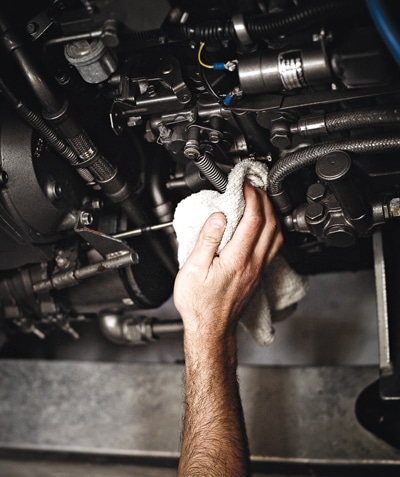
Spit and Polish in the Engine Room — Show a little lovin’
As far as I am concerned disposable diapers were invented to sit under pumps and motors that tend to weep or ooze oil. They are great placed under a machine during an oil top-off or filter change, and they even have self-adhesive strips to hold them in place. Toddler sizes are the best for marine use. String bags are great for storing rags. Hang them in areas of your engine room, clear of machinery, where you need quick and easy access. Do not buy rags: Tear up old T-shirts instead. Wash down the outside of hoses or fittings that carry salt water with a kettle of boiling-hot fresh water every so often. This prevents salt corrosion throughout the engine room and also makes saltwater leaks easier to pinpoint.
Subscribe to the Yachting Life newsletter for cruising and chartering guides, new boat announcements, event updates, special offers and more!


